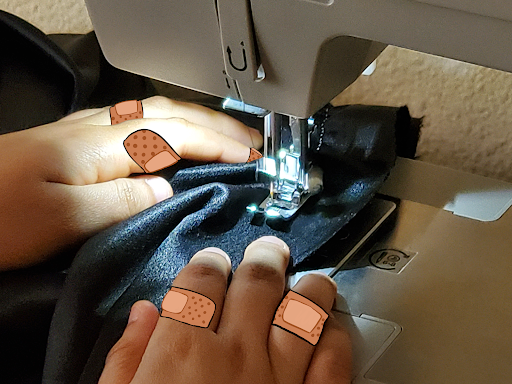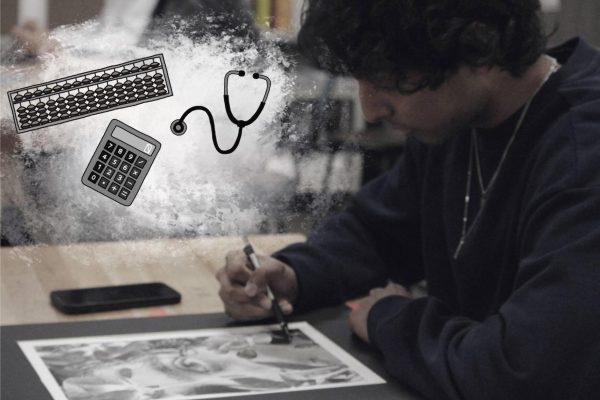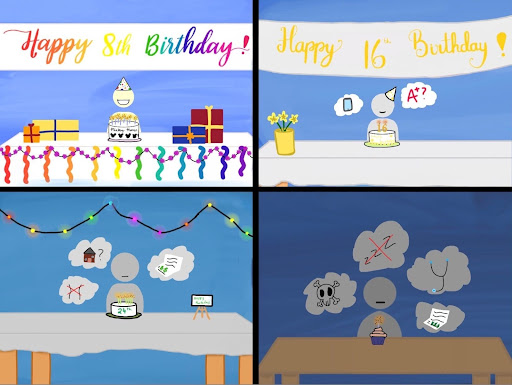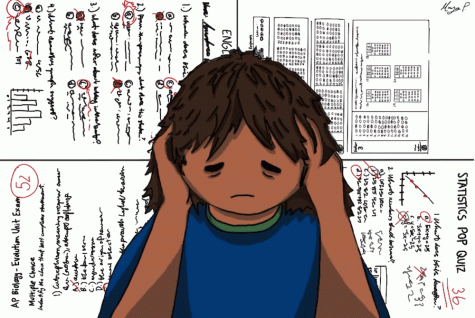Bathroom stalls see aggressive underground, student tensions
The bathroom stall seems to be the choice of platform for both hate speech and love speech.
Rushing to use the bathroom and still be on time, students pick a bathroom stall to use before 52 minutes of instruction. Once situated, the student looks to their right: swastikas are drawn in black sharpie on the rouge-red walls.
They look to their left: racial slurs and even death threats are scrawled in hastened writing. Unfortunately this is a long-running occurrence that seems to fall through the cracks at Coppell High School or any school for that matter.
“The Lakeville school district says a student will face discipline for putting racist and anti-Semitic graffiti on bathroom stalls at Lakeville South High School,” says Minnesota Public Radio News.
Racism is not the only problem that defaces bathroom stall walls.
“The week after President Donald Trump retracted government guidelines that allowed transgender students to use the bathroom of their choice, someone scrawled a death threat to gay students inside a gender neutral bathroom at Grant High School,” Bethany Barnes for The Oregonian said. “Grant families haven’t been told about the Feb. 27 graffiti, which has since been covered over with paint.”
Different schools have also taken different approaches, as seen at Gurnee High School in Gurnee, Illinois.
“While the school community said they are disappointed about the discovery of this message of hate,” Evelyn Holmes of ABC 7 Chicago Eyewitness News said. “They said it’s a good opportunity to talk about inclusion and not tolerating hate.”
Scranton Products, a company that creates and installs public bathroom facilities like toilets and stalls, released an online article specifically addressing how to stop vandalism in school bathrooms.
“One of the most effective ways to prevent graffiti in your school bathrooms is to use graffiti-resistant materials like HDPE,” the statement said. “HDPE, or high-density polyethylene, is a plastic material that’s resistant to graffiti, scratches, corrosion, and even germs.”
Special studies have also concluded that simply showing people are watching and caring about their bathrooms yields significant results. Dr. Watson of the University of Miami in Ohio found that posting a sign promising donations to charity every day the bathroom stalls remain graffiti-free influenced people to completely stop the vandalism after it had been cleaned off the walls.
“Prior to posting the signs,” Dr. Watson for The Guardian found, “Bare walls appeared to function as discriminative stimuli for graffiti, perhaps because it was not apparent that anyone cared. Posting the signs was evidence that a prominent citizen (a doctor) was prepared to pay for results.”
A less rare form of graffiti also appears on our stall walls. The usual jokes, random names declaring that they were once there too, and even messages of positivity have a life even in a public school bathroom. However, these are crowded out by the more crude messages of hatred in public stalls that students and faculty members have witnessed from decades of use.
Julie Beck, a journalist for The Atlantic, discovered Latrinalia – the study of public toilet graffiti. This field of study was developed by Stephen J. Anderson and William S. Verplanck and their work was published in a paper titled When Walls Speak, What Do They Say? which was published in the Psychological Record in 1983.
“Though some studies say women write just as much as men, men’s is typically seen as being more aggressive and more sexual, while women’s is more conversational and more likely to be about love,” Julie Beck for The Atlantic said. “Though most bathroom graffiti research was done in the 60s, 70s, and 80s, a couple studies done in the past few years have found similar things.”
Other studies later found that men were more likely to contribute to “presence-identifying” graffiti (i.e. scrawling your name) whereas women were actually more likely to write insults. The idea of stating your presence was correlated to traditional male values whereas putting others down was correlated with traditional female values.
So why do we see this kind of behavior? CHS and its students are slowly becoming a more socially progressive body and the tolerance for misogyny is falling at an increasing rate – as it should. Due to this trend, it is safe to connect the radical hatred that we see on the anonymous nature of bathroom stalls to our increasing awareness of social growth.
If people are taught that racism is bad in schools, but they still see examples of it in everyday life, it empowers them to promote this negative ideology. They can not be too open about it for fear of being ridiculed, so they seek a more anonymous platform. Sure you can find a lot of this online with Twitter and Facebook, but you can track those. You cannot track the handwriting of a stranger who wrote something years ago on your downstairs D-hall bathroom.
The walls of our bathroom stalls are canvases for students to let out their misogynistic aggression that would otherwise be deemed socially unacceptable. The messages of hatred will disappear and messages of love will replace them as long as people continue to grow and push for progress. Hatred can not merely be looked down upon – it should not even be tolerated.

Grant Spicer is a Senior and second year staff writer for The Sidekick. Grant specializes in writing opinions articles and answering those difficult questions.














Bethany Grace Howe • Feb 26, 2018 at 10:21 am
I read online that the Coppell ISD itself had at one time a policy of allowing students to use the bathroom of their self-identified gender. Is that still the policy in place in the high school and the district as a whole?